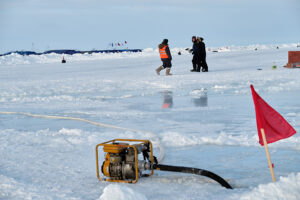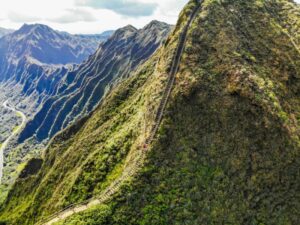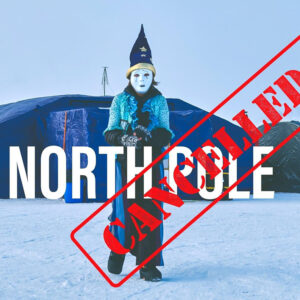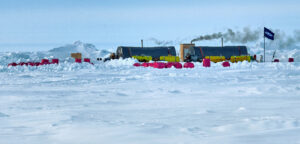We planned our expedition to Iceland as part of our Big Ice Expeditions project, aiming to cross some of the largest & most technical ice fields in the world. Our goal was to complete an unsupported crossing of the 3 largest icecaps there – the Vatnajokull (largest glacier in Europe), Hofsjokull and Langjokull – in Autumn.
Completely understanding that this is the worst time of the year to do it, second only to the dangerous winds of late Jan/early Feb, we planned 20 days for the trip – 14-16 days on the move and 4 spare days for bad weather.
The team – my girlfriend and I.
This was essentially a training trip for future expeditions, as she had little experience with skis and on glaciers. We wanted to work on our cohesion as a team in extreme weather.

Approaching the Vatnajokull on the Snaefellsleid
Starting from the Snaefellskali hut we approached the Vatnajokull in a storm, camped near the Bruarjokull glacier and climbed to the plateau the next day in perfect weather. Another 5 days and two major storms took us across the first of our objectives. Naturally, we saw the most magnificent views just before, just after, or during the storms. We didn’t stop moving even in the worst of conditions, using pre-planned GPS checkpoints and some good old-fashioned compass navigation techniques. We also made perfect use of the crevasse maps issued by Safetravel.is and coordinated our trip with their trip monitoring service. To our luck, conditions on the Vatnajokull were just perfect. Not a single crevasse in sight!

M’lady on Vatnajokull’s plateau
Following a night at the Sylgjufell hut, a day across а small Lava field and two more days through the Central highlands lead us to crossing the frozen (luckily!) tributaries and main flow of the Tjorsa river, in order to climb onto Hofsjokull’s plateau.

M’lday, carrying more than half her weight over the lava field

Hofsjokull is the most dangerous of the three icecaps, despite being the smallest. It has quite an alpine-like nature with amazing nunataks and dangerous crevasse fields. To our luck, the summer had been cold and very little snow melt had occurred. Thus, most crevasses were quite filled up with snow. However, we roped up for most of the glacier and only encountered some interesting and somewhat dangerous terrain when exiting from the glacier to the W-SW near the Svartakvisl river.

Crevasses in the lower parts of Blondujokull.


For the remainder of that day, we mostly skied right on top of the frozen river and a few snowed up-valleys to reach the Hveravellir hut in a mild storm.
A night there, some equipment re-checks, fixes and re-packing and off we headed towards our third objective – the Langjokull icecap.
We opted to cross it along its entire length and managed to do so in 4 days.
Day one was wasted on a hard approach with constant problems with our skins. However, we managed to climb up on the glacier itself. On day 2, we waited out a bad storm, and on day three, skin issues forced us to continue forward walking just in our boots. The snow was mostly icy, so we could keep up with a 3-4km/h pace and managed to cross halfway across, to the Thursaborg nunatak, and camped below it.

By that point, our tent had fucked up completely – both vestibule zippers had broken, the roof “cover” attachment points have broken too, and regardless of conditions, the tent kept forming condensation on the inside of the inner tent every single night since day one. Production material issues obviously…but that kept us up at night constantly wiping and brushing the condensation off walls and sleeping bags. The number of f-words that tent withstood…God Almighty!
So early in the winter (or late in the summer, as local Glaciologists look at it :D) conditions did not permit digging a snow cave, so it was clear we had to sleep in the tent again. The sunset was absolutely epic and that only meant a storm on the next day.

Starting before sunrise, on day 15, we raced ahead of the storm, and crossed the remaining 30km of the icecap, reaching Jaki hut in the late afternoon…mostly walking in our boots again 😀
That same night, local guides picked us up and drove us to our hostel in Reykjavik.
Lucky, once again.
All in all, it was an absolutely lovely training expedition. We worked great as a team and even had to cross somewhat technical terrain. We took 15 days to achieve our goal, but that’s the least important of it all.
What’s best is all the sharing we lived through – we shared the workload, we supported each other and needed little words to organize all the work required.
There’s one thing from the expedition that will stay with me forever – the shared looks and nods while moving in the worst of storms – those moments when you feel smashed by nature, cold, tired, frustrated…and you know your partner feels the absolute same. But that look…and that almost unnoticable nod – that’s all you need to keep pushing and give it all your best!
A team, ticking like clockwork, every single day, regardless of how bad it was.
I guess that’s what’s most important in the end. Being able to share a story with someone as crazy as you are.
PS:
Our expedition had a cause in supporting children at risk of being taken from their parents. If you have the time, please checkout the fb & instagram pages of #chilipepperscause.
Thanks!





